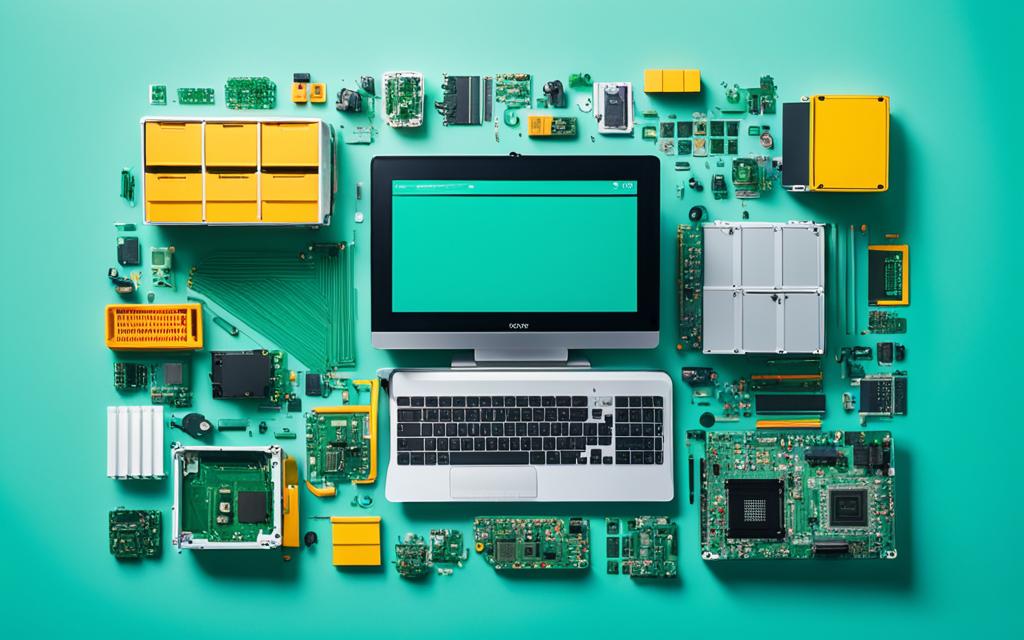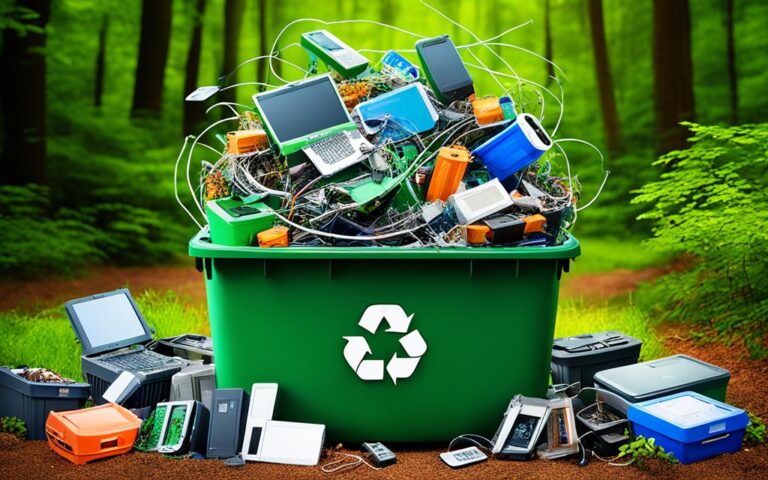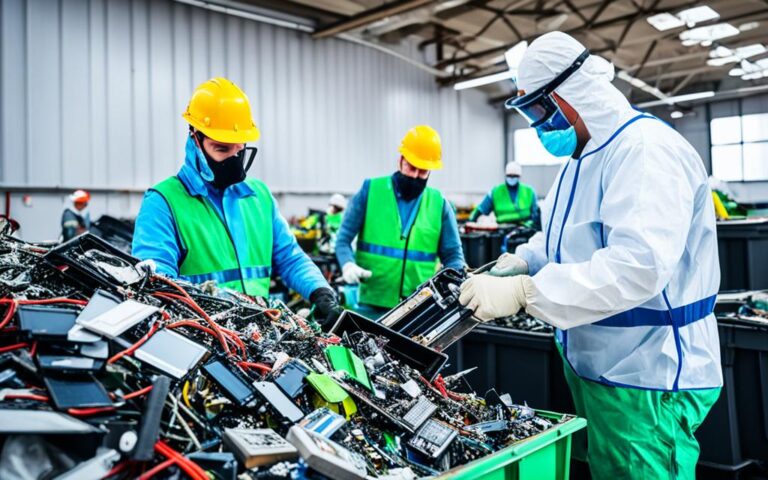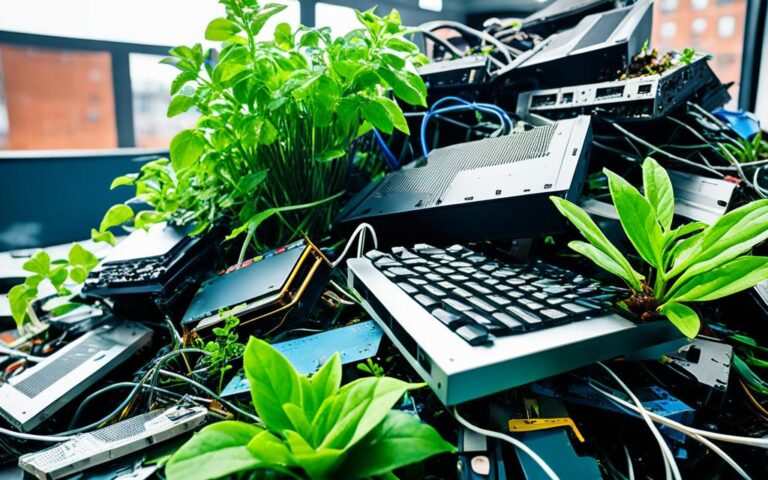Circular Economy for Computers: A Vision for the Future
The concept of circular economy aims to reimagine the linear economy, where resources are taken from the Earth, used to create products, and eventually discarded as waste. The circular economy, on the other hand, focuses on keeping resources in use for as long as possible through responsible recycling and innovative reuse practices. It involves using fewer resources, reusing materials, and finding new ways to use existing resources. The World Economic Forum (WEF) has been at the forefront of promoting circular economy initiatives through its flagship initiative, Scale360°. The WEF aims to support innovators in thinking circular and scale their circular innovations globally. The circular economy is not just about environmental sustainability but also presents economic opportunities for businesses.
The Importance of Circular Economy
The circular economy is crucial for addressing the environmental impacts of production and consumption. By reducing waste and reusing materials, businesses can minimize their carbon footprint and contribute to sustainability goals.
One of the key benefits of embracing a circular economy is its potential to create a significant business opportunity. This is especially true in sectors with hard-to-abate materials such as aluminum, steel, concrete, and plastics. Adopting circular approaches in these sectors has the potential to reduce emissions by 50% by 2040.
Furthermore, the circular economy has garnered attention in terms of supply chain resilience and the impacts of supply chains on the environment. Implementing circular practices requires a shift in the economic system, but it also presents opportunities for businesses to capitalize on economic and resiliency benefits.
By embracing the circular economy, businesses can not only reduce their environmental impact but also unlock new business opportunities and contribute to a more sustainable future.
The Environmental Impacts of Circular Economy
The environmental impacts of production and consumption are significant challenges that need to be addressed. From greenhouse gas emissions to resource depletion, these impacts pose a threat to the long-term sustainability of our planet.
By embracing circular economy principles, businesses can play a crucial role in mitigating these impacts. The circular economy aims to minimize waste by keeping resources in use for as long as possible. This not only reduces the amount of waste that ends up in landfills but also decreases the need to extract and process new raw materials.
Example: In the construction sector, adopting circular approaches can lead to significant reductions in environmental impacts. By reusing materials from demolished buildings and implementing design strategies that promote durability and recyclability, the sector can minimize its carbon footprint and contribute to sustainability goals.
The Business Opportunity
The circular economy presents a significant business opportunity for companies across various industries. By adopting circular practices, businesses can unlock new revenue streams and enhance their competitiveness in the market.
For instance, implementing circular approaches can lead to cost savings through more efficient use of resources. It can also open up possibilities for developing innovative products and services that cater to the growing sustainability demands of consumers.
Example: Beverage companies can transition from single-use plastic bottles to refillable glass bottles, reducing plastic waste and building customer loyalty through sustainable packaging solutions.
In addition to direct economic benefits, embracing the circular economy can also enhance brand reputation and attract environmentally conscious customers.
The Path to a Circular Economy
Achieving a circular economy requires collaboration and systemic changes across various stakeholders, including businesses, governments, and consumers.
Businesses can take the lead by adopting circular practices and integrating sustainability into their core strategies. They can engage in responsible sourcing, design products with circularity in mind, and implement recycling and materials recovery programs.
Governments play a crucial role in creating an enabling environment for the circular economy by implementing regulatory frameworks, promoting research and development, and providing incentives for businesses to adopt circular practices.
Consumers also have a role to play in driving the transition to a circular economy. By making informed purchasing decisions and supporting businesses that prioritize sustainability, consumers can create demand for circular products and services.
| Benefits of Circular Economy | Examples |
|---|---|
| Reduces environmental impacts | Reuse of materials to minimize waste |
| Creates business opportunities | Development of innovative products and services |
| Enhances brand reputation | Attracts environmentally conscious customers |
| Promotes sustainability goals | Reduces greenhouse gas emissions |
In conclusion, embracing the circular economy is not only crucial for addressing environmental impacts but also presents a significant business opportunity. By reducing waste, reusing materials, and embracing circular practices, businesses can contribute to sustainability goals while unlocking economic benefits. The transition to a circular economy requires collaboration and systemic changes, but the potential for a more sustainable and prosperous future is within reach.
Computer Vision and the Circular Economy
Computer vision technology, powered by advanced algorithms and machine learning models, plays a significant role in advancing the circular economy. It can be particularly applied in tracking and analyzing the lifecycle of products, allowing manufacturers and supply chain managers to better understand the environmental impacts of their products and make more sustainable design and production decisions.
Computer vision can also enhance waste reduction efforts by improving the sorting and categorization of recyclable materials, making it easier to recover and reuse valuable resources. By accurately identifying different materials in a waste stream, computer vision helps optimize the recycling process, increasing efficiency and minimizing waste.
“Computer vision can revolutionize the way we tackle waste reduction by enabling better sorting and categorization of recyclable materials.” – [Name]
This technology also presents opportunities for energy and resource savings. By utilizing computer vision to analyze production processes and identify areas of inefficiency, businesses can implement strategies to minimize energy consumption and optimize resource utilization, leading to cost savings and reduced environmental impact.
Moreover, computer vision has the capability to monitor and analyze environmental impacts at both local and global scales using satellite imagery and remote sensing data. This enables businesses and policymakers to make informed decisions based on accurate and up-to-date information, driving further sustainability efforts.
The Benefits of Computer Vision in the Circular Economy:
- Improved tracking and analysis of product lifecycles
- Enhanced waste reduction through accurate sorting and categorization
- Opportunities for energy and resource savings
- Monitoring and analysis of environmental impacts
With the integration of computer vision technology, the circular economy can be further accelerated, contributing to the goals of waste reduction, energy efficiency, and environmental sustainability.
| Benefits of Computer Vision | Impact in the Circular Economy |
|---|---|
| Improved tracking and analysis of product lifecycles | Allows manufacturers and supply chain managers to make more sustainable design and production decisions |
| Enhanced waste reduction through accurate sorting and categorization | Facilitates the recovery and reuse of valuable resources |
| Opportunities for energy and resource savings | Enables businesses to minimize energy consumption and optimize resource utilization |
| Monitoring and analysis of environmental impacts | Provides accurate data for informed decision-making and driving sustainability efforts |
Circular Economy and AI Waste Sorting Robots
AI waste sorting robots equipped with computer vision technology are revolutionizing recycling processes and driving the transition to a truly circular economy. Computer vision technology allows these robots to scan and identify different materials in a waste stream, making the sorting process faster, more accurate, and more efficient. By automating the sorting process, AI waste sorting robots enable more waste to be sorted within a specific timeframe, increasing recycling outputs and accelerating the recycling process. This technology optimizes the cost-effectiveness of recycling by reducing or eliminating the need for manual sorting. The integration of computer vision and robotics in recycling facilities maximizes the efficiency and accuracy of sorting recyclables, contributing to the overall goals of a circular economy.
| Benefits of AI Waste Sorting Robots in the Circular Economy |
|---|
| Achieves faster and more accurate sorting of recyclable materials |
| Increases recycling outputs and accelerates the recycling process |
| Optimizes cost-effectiveness by reducing or eliminating the need for manual sorting |
| Enhances the efficiency and accuracy of sorting recyclables |
| Contributes to environmental sustainability and resource conservation |
The integration of AI waste sorting robots with computer vision technology is a game-changer in the circular economy revolution. By leveraging advanced algorithms and machine learning models, these robots not only streamline recycling processes but also contribute to the transformation of waste management practices. They play a vital role in maximizing the value of recyclable materials and reducing the environmental impact of waste. As the circular economy continues to gain momentum, AI waste sorting robots will play an increasingly significant role in achieving sustainable and efficient recycling processes.
Conclusion
The circular economy presents a vision for a more sustainable future, where resources are conserved and waste is minimized. In the pursuit of this vision, computer vision technology has emerged as a powerful tool. Through the use of computer vision algorithms and machine learning models, businesses can gain a deeper understanding of the environmental impacts of their products. Armed with this knowledge, they can make informed decisions to design and produce more sustainable goods, reducing their ecological footprint.
One of the key areas where computer vision technology is making a significant impact is in recycling processes. AI waste sorting robots equipped with computer vision technology have revolutionized the way materials are sorted and recycled. By accurately identifying different materials in waste streams, these robots enhance efficiency and accuracy in sorting, leading to increased recycling outputs. This not only speeds up the recycling process but also optimizes cost-effectiveness by reducing the need for manual sorting.
As technology continues to advance, the marriage between the circular economy and computer vision technology becomes even more powerful. These innovations pave the way for a more sustainable and circular economy, not just for computers but for a wide range of industries. By harnessing the potential of computer vision technology, businesses can contribute to the principles of sustainability, resource conservation, and responsible recycling, ultimately shaping a brighter and greener future for all.
FAQ
What is the circular economy?
The circular economy is a concept that aims to reimagine the linear economy by keeping resources in use for as long as possible through responsible recycling and innovative reuse practices.
What is the role of the World Economic Forum in promoting the circular economy?
The World Economic Forum (WEF) promotes circular economy initiatives through its flagship initiative, Scale360°. It aims to support innovators in thinking circular and scaling their circular innovations globally.
What are the environmental impacts addressed by the circular economy?
The circular economy is crucial for addressing the environmental impacts of production and consumption, including waste reduction, minimizing carbon footprint, and achieving sustainability goals.
What business opportunities does the circular economy present?
The circular economy presents significant business opportunities, especially in sectors with hard-to-abate materials like aluminum, steel, concrete, and plastics. Circular approaches in these sectors can reduce emissions by 50% by 2040.
How does computer vision technology contribute to the circular economy?
Computer vision technology plays a significant role in advancing the circular economy by tracking and analyzing the lifecycle of products, improving waste reduction efforts, identifying opportunities for energy and resource savings, and monitoring environmental impacts through satellite imagery and remote sensing data.
How do AI waste sorting robots with computer vision technology contribute to the circular economy?
AI waste sorting robots equipped with computer vision technology revolutionize recycling processes by scanning and identifying different materials in a waste stream, making the sorting process faster, more accurate, and more efficient. They optimize recycling by increasing sorting outputs, accelerating the recycling process, and reducing or eliminating the need for manual sorting.













